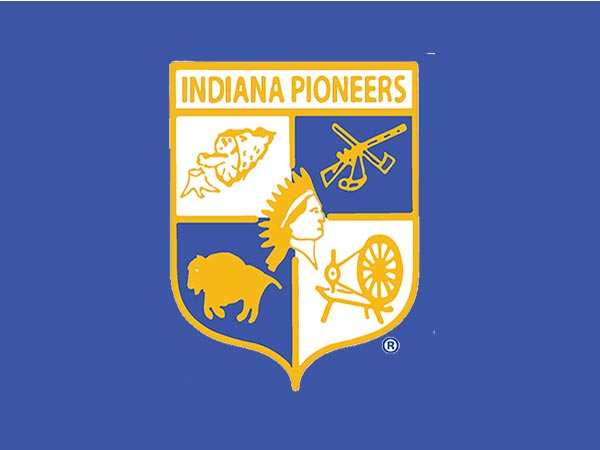“Whole Lotta Shakers Goin’ On”
South Union and Pleasant Hill, Kentucky
Saturday and Sunday, April 8-9, 2000
By Robert H. Everitt
The spring 2000 pilgrimage of The Society of Indiana Pioneers included visits to two Shaker villages established in the early nineteenth century in our neighboring state of Kentucky. The United Society of Believers in Christ’s Second Coming, known to the world as Shakers because of their ritualistic dances, was nineteenth-century America’s largest and best-known communal society. Their movement (no pun intended) began in New York State shortly after the revolution, and by the 1840s, nearly 6,000 Shakers lived in communities from Maine to Kentucky. One Shaker community was established in Indiana, north of Terre Haute, but none of the buildings are in existence today.
Led by Eadie Barrie of the Indiana Historical Society, the happy travelers set out by motor coach early on Saturday, April 8, for the long trip to our first stop in South Union, Kentucky, near Bowling Green.
South Union was one of the 24 villages established by the Shakers. During the village’s 100-year history, the Shakers acquired and worked 6,000 acres of farmland, constructed over 200 buildings, and maintained industries for which they gained a national reputation. The group was treated to a personally guided tour of the Shaker Museum, housed in one of the well-preserved structures erected to house one of the “families” of the village. Because celibacy was required of all believers and residents of these villages, there were no traditional families in the villages, but they were divided into groups who shared living quarters, though the men and women were strictly separated within the residences by separate stairways and entry doors. Several rooms were furnished as they might have been in the mid-nineteenth century.
Our lunch was served in The Shaker Tavern, built in 1869 by the Shakers of South Union as a hotel for the “people of the world”. For over 30 years, the Shaker Tavern maintained a thriving business catering to the Victorian railroad travelers who stopped in South Union. Today, the Tavern is open to the public and provides a unique bed and breakfast experience.
Our next stop was Pleasant Hill, another of Kentucky’s Shaker communities, near Harrodsburg. Established in 1805 on a high plateau above the Kentucky River, the community grew to as many as 500 residents and 4,000 acres of land by mid-century. By 1910, however, only a few Shakers survived, and the village was closed. For the next 50 years, Pleasant Hill existed as a small farm community. In 1961, a nonprofit group was formed to preserve its heritage. Since that time, 33 original buildings have been restored and 2700 acres of farmland preserved. Today, Pleasant Hill is a model for historic preservation. A National Historic Landmark from boundary to boundary, it is the only site where all visitor services are provided in original buildings.
The Pioneers were treated to a sumptuous dinner in the Trustees’ Office dining room, followed by a splendid program on Shaker music by one of the interpreters in the historic Meetinghouse. Strolling the streets of the village at night without glaring street lights, no motorized vehicles, and only minimal lighting in the windows of the structures was magical. After a full day immersed in Shaker history, the traveling Indiana Pioneers retired to their rooms in the West Family Dwelling and the West Family Sisters’ Shop.
Following a breakfast buffet in the Trustees’ Office and a brief orientation, the group was free to wander around the village, each at his or her own pace. Among the structures that were open – each staffed with a knowledgable, costumed interpreter – were the Centre Family Dwelling, Farm Deacon’s Shop, East Family Wash House, East Family Sisters’ Shop, and the Historic Farming Barn. Craft demonstrations included broom making (Shakers are noted for having first made the “flat” broom), coopering, spinning, and weaving. As we re-entered the 21st century, we were afforded the opportunity to visit the unique gift shop before boarding our motor coach for the short trip to our luncheon destination, The Beaumont Inn in Harrodsburg.
At the Beaumont Inn, we were treated to a brief presentation on its history by our host, Chuck Dedman, Innkeeper and great-grandson of the founder of the Inn. Constructed in 1845 as a school for young ladies, the building housed, in succession, the Greenville Institute, Daughters’ College, and Beaumont College until it was purchased by Mr. and Mrs. Clave Goddard in 1917. Mrs. Goddard converted the structure into the Beaumont Inn, and during its entire history, four generations of the Goddard-Dedman family have maintained the tradition, the style, and the ambiance of the grand Southern manner. Our Sunday brunch gave evidence of this family’s attention to every detail to make our stay a pleasant one.
With special thanks to our experienced and well-prepared tour host, Eadie Barrie, and to the Indiana Historical Society for its cooperation, the group of Indiana Pioneers returned to Indianapolis, concluding a very successful and unique pilgrimage.
